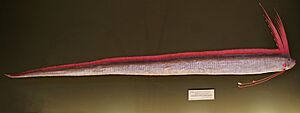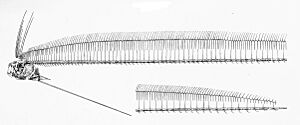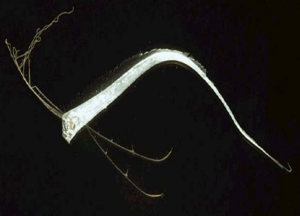Giant oarfish facts for kids
Quick facts for kids Giant oarfish |
|
|---|---|
 |
|
| A taxidermied specimen of Regalecus glesne in Naturhistorisches Museum Wien | |
| Conservation status | |
| Scientific classification | |
| Synonyms | |
|
Synonyms
Cephalepis octomaculatus Rafinesque, 1810 Cepola gladius Walbaum, 1792 Gymnetrus ascanii Shaw, 1803 Gymnetrus banksii Valenciennes, 1835 Gymnetrus capensis Valenciennes, 1835 Gymnetrus gladius Valenciennes, 1835 Gymnetrus grillii Lindroth, 1798 Gymnetrus hawkenii Bloch, 1795 Gymnetrus longiradiatus Risso, 1820 Gymnetrus telum Valenciennes, 1835 Regalecus banksii (Valenciennes, 1835) Regalecus caudatus Zugmayer, 1914 Regalecus jonesii Newman, 1860 Regalecus masterii De Vis, 1891 Regalecus pacificus Haast, 1878 Regalecus remipes Brünnich, 1788 |
The giant oarfish (Regalecus glesne) is a very long, thin fish. It lives deep in the ocean. This amazing fish is found all over the world, except near the North and South Poles. People sometimes call it the Pacific oarfish, the king of herrings, or the ribbonfish.
The giant oarfish is the longest bony fish on Earth. It looks like a giant ribbon swimming through the water. It has a long fin along its back and special oar-shaped fins on its belly. These fins are why it's called an "oarfish." Its body is silver and blue, with bright red fins. Because of its strange looks and wavy swimming, some people think it might be the source of old "sea serpent" stories.
Contents
What's in a Name?
The giant oarfish was first described in 1772 by a scientist named Peter Ascanius. Its scientific name, Regalecus, means "belonging to a king." The second part, glesne, comes from a farm in Norway where the first known specimen was found.
It's also called the "king of herrings." This might be because it has a crown-like crest on its head. Fishermen also used to see it near groups of herring fish. They thought the oarfish was guiding the herring. The name "oarfish" likely comes from its long, oar-shaped pelvic fins. It could also refer to its long, slender body shape.
Where Do Giant Oarfish Live?
The giant oarfish lives in oceans all around the world. It has been found from far north to far south. However, it is most common in warmer, tropical waters. This fish travels across the ocean to follow its main food sources.
Scientists believe it lives in the parts of the ocean where sunlight still reaches. It can also go deeper, into dimly lit areas. It has been found as deep as 1,000 meters (about 3,300 feet) below the surface.
What Does a Giant Oarfish Look Like?
This fish holds the record for being the longest bony fish. The longest one ever found was about 17 meters (56 feet) long! Most giant oarfish are usually around 3 meters (10 feet) long.
Young oarfish, called larvae, look a bit different from adults. They have a very long body with rays coming from their head. Their skin is almost clear, with dark spots. Unlike adults, young oarfish have a tail fin.
Adult oarfish have a ribbon-like body that is very thin from side to side. A long fin runs along its entire back, from its eyes to its tail. The first few rays of this back fin are longer and form a bright red crest on its head. Its small fins near its head are stubby. The two long, single fins on its belly look like oars. Its head is small, and its mouth can stick out. It does not have any teeth.
The important organs of the giant oarfish are mostly near its head. This might help it survive if it loses a big part of its tail. It does not have a swim bladder, which most fish use to control their depth. The oarfish's liver is orange or red. This color comes from the food it eats.
Life Cycle of the Giant Oarfish
Scientists have learned some things about young oarfish by studying them in labs. In 2020, they watched oarfish eggs hatch into larvae for the first time. The eggs took 18 days to hatch. The tiny larvae looked similar to other fish larvae, swimming head-down.
In the wild, giant oarfish lay their eggs from July to December. Their eggs are small, about 2.5 millimeters (0.1 inches) wide. These eggs float near the surface of the ocean until they hatch. Young oarfish are also seen near the surface during this time. Oarfish do not reproduce all the time. They have special periods for laying eggs, usually at the end of summer. After this, they stop reproducing for the rest of the year.
How Do Giant Oarfish Behave?
Not much is known about how oarfish behave in the wild. They have been seen swimming by moving their long back fin. They have also been seen swimming straight up and down in the water.
In 2010, scientists filmed a giant oarfish in the Gulf of Mexico. This was the first time a giant oarfish was clearly filmed in its natural home. The video was taken by a robot submarine. It showed the fish swimming straight up and down, with its tail pointing downwards.
Giant Oarfish and Humans

People do not usually fish for giant oarfish. However, they sometimes get caught by accident in fishing nets.
Because of their huge size and long, wavy bodies, giant oarfish are thought to be the reason for some old stories about "sea serpents." People used to think these fish were very rare. Now, scientists think they might be quite common, but it's still unusual to see a healthy one in its natural ocean home.
The giant oarfish and a similar fish, R. russelii, are sometimes called "earthquake fish." This is because some people believe they come to the surface before or after an earthquake.





